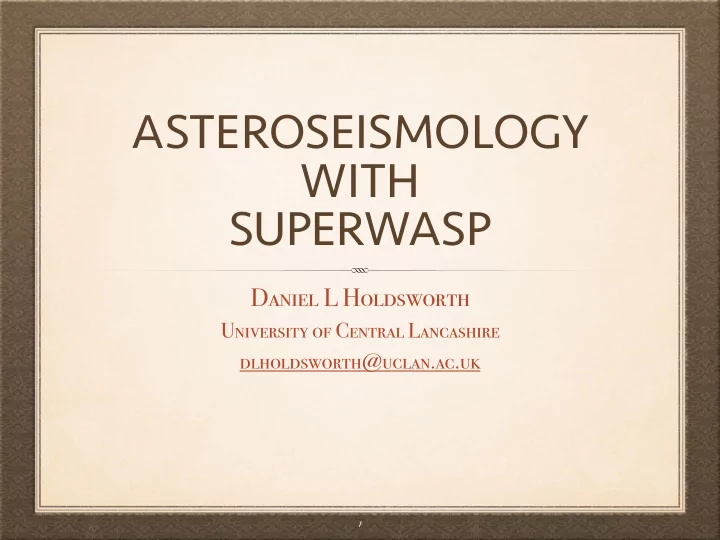

ASTEROSEISMOLOGY WITH SUPERWASP Daniel L Holdsworth University of Central Lancashire dlholdsworth@uclan.ac.uk 1
SUPER WIDE ANGLE SEARCH FOR PLANETS SuperWASP is a UK based consortium performing the worlds largest survey for transiting extrasolar planets Over 150 planets discovered so far… 2
THE WASP INSTRUMENTS Fully Automatic: Roll - o ff roof system 8 cameras mounted in a 2x4 configuration Standard 200mm telephoto lenses 8x8 degree FOV 13.7” Pixel size Broadband filters 3
FILTER RESPONSE FUNCTION 4000 - 7000Å Ideal for transiting planets Not ideal for hot stars 4
OBSERVING STRATEGY Capable of observing entire sky in ~40 min Takes two 30s exposures back - to - back Focuses on pre - programmed ‘hot spots’ Returns to the same patch of sky every ~10 mins Typically 3000 data point per season of 100 - 150 days 5
OBSERVATIONS 6
SUPERWASP PHOTOMETRY Automated photometry extraction pipeline USNO B1.0 input catalogue 3.5 pixel aperture = 48” T ransformed to Tycho - 2 V magnitudes corrected for primary & secondary extinction Systematics removed with SysRem ( Tamuz+ 2005 ) Better than 1 % for V<11.5 nd 0.5 % for V<9.4 Pollacco+ 2006 7
SUPER WIDE ANGLE SEARCH FOR PLANETS Pulsations! >31 million stars Multi - season multi - site photometry Large database of time - series photometry Statistical studies of variable stars Find ‘rare’ pulsators http://astro.phys.au.dk/ % 7Ejcd/HELAS/puls_HR/ 8
WASP CAPABILITIES Detection limit of Dependant on: ~0.5mmag for V<11 Blending Magnitude Noise Data length Holdsworth 2015 9
WHAT’S IN THE ARCHIVE? 10
LOW-FREQUENCY VARIABLES - 1 ~80,000 targets with frequencies 5 - 50d Plagued by aliasing Harmonics of binaries Require a star - by - star analysis Studies include: Pulsations in Am stars ( Smalley+ 2011 ) Am binary stars ( Smalley+ 2014 ) λ Boo stars with γ Dor & δ Sct pulsations ( Paunzen+ 2014, 2015 ) See Paul’s talk next Rotational modulation of CP stars ( Bernhard+2015 ) & Barry’s on Friday 11
HIGH-FREQUENCY VARIABLES These include some of the rarer pulsating stars: The roAp stars Short period δ Sct stars Compact pulsators 12
HIGH-FREQUENCY VARIABLES These include some of the rarer pulsating stars: The roAp stars Short period δ Sct stars Compact pulsators 13
PMS STARS HD 34282 Pre - main sequence star IR excess High - frequency δ Sct pulsations 79.5 & 71.3 d - 1 Amando+ 2004 See Konstanze’s talk on Thursday 14
SDBV STARS Able to probe to at least 1440 d - 1 Noise is not fully characterised At least 3 newly identified p and g modes in single star Holdsworth+ in prep 15
WASP DATA TO SUPPLEMENT KEPLER (K2/TESS) OBSERVATIONS KIC 7106205 Amplitude variable star ( Bowman & Kurtz 2014 ) Amplitude drops from ~5mmag to 0.5mmag See Dominic’s talk tomorrow 16
WASP DATA TO SUPPLEMENT KEPLER (K2/TESS) OBSERVATIONS KIC 7106205 Amplitude variable star ( Bowman & Kurtz 2015 ) Amplitude drops from ~5mmag to 0.5mmag 17
WASP DATA TO SUPPLEMENT KEPLER (K2/TESS) OBSERVATIONS KIC 7106205 Amplitude variable star ( Bowman & Kurtz 2015 ) Amplitude drops from ~5mmag to 0.5mmag Bowman 2016 18
SUMMARY Over 31 million objects ‘ All’ - sky coverage in approx. V - band Test for variability in the range of minutes to a decade Caution: large pixels make blending an issue Ideal for extending Kepler/K2/TESS observations and proposing targets for the K2/TESS missions!! 19
Recommend
More recommend